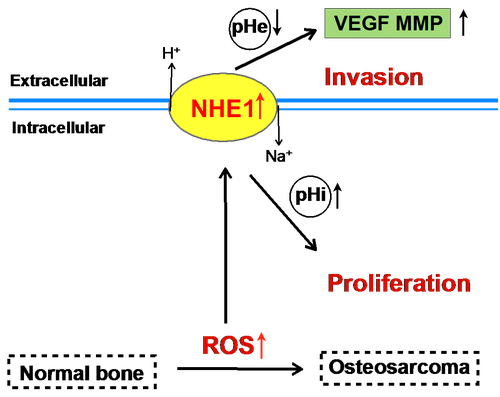-
Home
-
About JCTR
-
Gold Open Access
-
Issues
-
Editorial board
-
Author guidelines
-
Publication fees
-
Online first
-
Special issues
-
News
-
Publication ethics
-
Partners
-
Submit your manuscript
-
Submit your review report
-
Editorial Office
-

This work is licensed under a Creative Commons Attribution-NonCommercial 4.0 International License. ISSN print: 2382-6533 ISSN online: 2424-810X
Volume 1 Issue 3
Osteosarcoma cell proliferation and migration are partly regulated by redox-activated NHE-1
Hua Bai, Guojing Chen, Congwen Fang, Xuekang Yang, Sixun Yu, Chunxu Hai*
Bai et al., J Clin Tranl Res, 2015; 1(3): 168-179
Published online: 12 December, 2015
Abstract
Background: Osteosarcoma (OS) is the most common primary malignant bone tumor in children and adolescents. OS is associated with locally aggressive growth and high metastatic potential. The mechanisms that underlie these processes are currently elusive. Reactive oxygen species (ROS) and Na+/H+ exchanger 1 (NHE1) have been suggested to regulate proliferation and migration of tumor cells. However, the relationship between NHE1 and ROS in OS proliferation and migration has not been investigated before.
Aim: To investigate the role of NHE1 and ROS in the proliferation and migration of OS.
Methods: ROS levels and NHE1 expression were studied in cultured human OS cells and human OS xenografts in nude mice. In vitro, OS cells were treated with different doses of tert-butyl hydroperoxide (tBHP), a ROS inducer, and cariporide, an NHE1 inhibitor, to study the effect on cell proliferation and migration. In vivo, nude mice bearing OS cells were administrated with NHE1 inhibitor or antioxidant and the tumor weights were measured.
Results: This study reported for the first time that the expression of NHE1 and intracellular ROS level were both increased in OS tissues and cells. Exposure of OS cell to ROS derived from tBHP was able to accelerate cell proliferation and migration and also up-regulate NHE1 protein expression. Moreover, tBHP significantly increased intracellular pH (pHi), decreased extracellular pH (pHe) and induced upregulation of ERK, MMP2, and MMP9. Lowering of ROS levels with the anti-oxidant DMTU or inhibiting NHE1 activity via cariporide abolished the stimulatory effect of tBHP. However, there cariporide did not affect intracellular ROS levels. In vivo study we further confirmed that cariporide could inhibit tumor growth in the nude mouse xenografts of OS cells.
Conclusions: The data demonstrate that up-regulation of NHE1 was induced by low concentrations of ROS contributes to the regulation of tumor proliferation and invasion of OS.
Relevance for patients: There is potential application for cariporide as an effective antitumor agent during the development of human osteosarcoma. In addition, redox modulation on proton transport may represent a novel target of osteosarcoma prevention, and open a new avenues for future research.

DOI: http://dx.doi.org/10.18053/jctres.201503.003
Author affiliation
1 Department of Toxicology, Shaanxi Provincial Key Lab of Free Radical Biology and Medicine, the Ministry of Education Key Lab of Hazard Assessment and Control in Special Operational Environment, School of Public Health, Fourth Military Medical University, Xi’an, Shaanxi 710032, China
2 Department of Orthopedics, Xijing Hospital, Fourth Military Medical University, Xi’an, Shaanxi 710032, China
3 Department of Burns and Cutaneous Surgery, Xijing Hospital, Fourth Military Medical University, Xi’an, Shaanxi 710032, China
*Corresponding author:
Chunxu Hai
Department of Toxicology, Shaanxi Provincial Key Lab of Free Radical Biology and Medicine, the Ministry of Education Key Lab of Hazard Assessment and Control in Special Operational Environment, School of Public Health, Fourth Military Medical University, Xi’an, Shaanxi 710032, China
Tel: +86-2983374879
Email: cx-hai@fmmu.edu.cn
Handling editor:
Michal Heger
Department of Experimental Surgery, Academic Medical Center, University of Amsterdam, Amsterdam, The Netherlands

